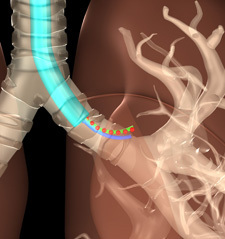by
Loren Bonner, DOTmed News Online Editor | April 17, 2013

Various pathways of a surgical tool
in a human lung
(Credit: Edgar Lobaton)
Surgeons could one day perform image-guided procedures by simply following the same principles of a GPS device. According to a new report, researchers are making progress on developing a new tool to help doctors use X-rays, in the most efficient way possible, to track devices used during image-guided minimally invasive surgical procedures.
Researchers from North Carolina State University and the University of North Carolina at Chapel Hill (UNC) want to precisely monitor the shape of what are known as continuum robots, essentially new tools that are being developed right now for minimally invasive procedures. These robots differ from existing systems in that they are based on pre-curved elastic tubes that are even less invasive and can reach areas otherwise impossible to get to. Because they are pliable, one of the main challenges for surgeons is figuring out where they are located. This requires images, such as radiographs or fluoroscopy, to determine the precise location.
The research team, led by Edgar Lobaton, developed an algorithm that can determine the fewest number of X-rays that need to be taken — in an effort to limit the patient's exposure to radiation — and the angles they should be taken from in order to accurately map the robots through the patient's body.



Ad Statistics
Times Displayed: 45814
Times Visited: 1302 Ampronix, a Top Master Distributor for Sony Medical, provides Sales, Service & Exchanges for Sony Surgical Displays, Printers, & More. Rely on Us for Expert Support Tailored to Your Needs. Email info@ampronix.com or Call 949-273-8000 for Premier Pricing.
"This is really a real-time procedure, getting from this location to this," Dr. Edgar Lobaton, an assistant professor of electrical and computer engineering at NC State, told DOTmed News. "We need to quantify the uncertainty and our algorithm comes into play at that point."
Based on the procedure and the expected and unexpected behavior of the device, the computer algorithm tells the surgeon the ideal time to take an image and from which angle.
Lobaton said that most of his work up until now has been done in simulations, but his team is developing a simple physical test bed to be able to experiment with the algorithms.
"We are not using any phantoms or actual X-ray devices yet, but we expect to [do that] this summer," he said.

